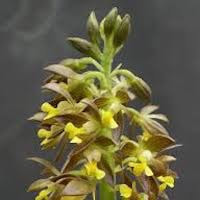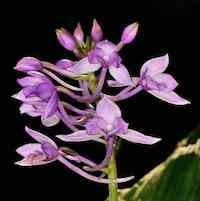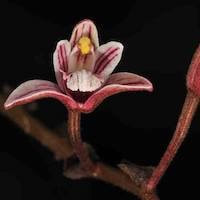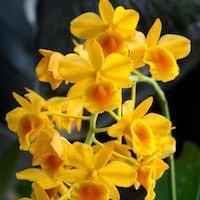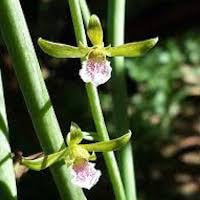WC6- Women's Citrus 6 - Planet of grapes
|
Native Singaporean Orchid notes: Vanda Mimi Palmer
According to Npark's website, the orchid called Vanda Mimi Palmer is considered "Exotic" and is found only in gardens or places where it's grown. Its flowers are fragrant and have unique dark brown patterns on their petals and sepals, with the lip showing a mauve color. Many fragrant hybrids are descended from this orchid, suggesting its scent is extraordinary. Its aroma is so special that it might be perfect on its own without mixing with other oils. This orchid is like a natural perfume, beautiful and aromatic all by itself.
|
Therapeutic Orchid notes:
|
Calanthe mannii Hook
Calanthe mannii Hook, also known as "Xihuaxiaji Lan" in Chinese (which translates to Small Flowers Prawn Spine Orchid), is used in traditional Chinese medicine. It is believed to help with conditions like stomach heat, scrofula (a form of tuberculosis affecting the lymph nodes), and abscesses. |
|
Calanthe masuca (D. Don) Lindl. Syn. Calanthe sylvatica (Thou.) Lindl.
The orchid known as Pakha phul, originating from Nepal, played a crucial role in creating the first hybrid orchids. It exhibits significant diversity: plants from China are larger, Nepalese varieties boast deep violet flowers, and those from Bhutan range from violet to purple. In traditional herbal practices across regions like Fujian, Jiangxi, Yunnan, Hunan, Guangxi, Guangdong, and Xizang, this orchid is valued for its medicinal properties. It is utilized for pain relief, reducing swelling, detoxification, and promoting healing, including treating abscesses. In Nepal, a paste made from its stem is used to treat dislocated bones, while its flowers are employed to stop nosebleeds, and its pseudobulbs are also used for this purpose. |
|
Callostylis bambusifolia (Lindl.) S.C. Chen & J.J. Wood Syn. Eria bambusifolia Lindl.
Known as Mundabai in India, Callostylis bambusifolia (previously Eria bambusifolia) is found across Vietnam, Thailand, Myanmar, southern Yunnan, and northeastern India down to Orissa state. Among the Dongria Kandha hill tribe in India, this orchid's entire plant is used traditionally for treating stomach upsets. A customary method involves burning Callostylis bambusifolia and another plant, Aegle marmelos (not an orchid), separately until they become ashes in earthen pots. These ashes are then combined in equal parts. To alleviate symptoms of hyperacidity and stomach upsets, half a tablespoon of this mixture is taken twice daily on an empty stomach for a week. |
|
Cymbidium ensifolium (L.) Sw.
Chinese names for Cymbidium ensifolium include Lan (orchid), Guo Lan (National Orchid), Gog Lan (Nation’s Orchid), and others. This orchid is famous for its beauty and fragrance, often depicted in Chinese art to symbolize grace and contentment. It's said that Chinese artists paint Cymbidium ensifolium when they feel joyful. Linked with Confucius, who likened good friends to the scent of orchids, this species grows widely in subtropical Asia, especially in autumn. In Traditional Chinese Medicine, it's used to nourish body fluids, improve circulation, soothe lungs, and ease coughs. It's also used for menstrual pain, amenorrhea, leucorrhea, dizziness, coughs, and tuberculosis-related symptoms. In India, its rhizomes are boiled for treating gonorrhea. |
|
Dendrobium chrysotoxum Lindl. Syn Dendrobium sauvissimum Rchb. f
Dendrobium chrysotoxum, known as Shwe tu and Mout khan war in Myanmar, features clustered, fusiform stems and is native to Vietnam, Laos, Thailand, southern Yunnan, Myanmar, and Sikkim. It contains erianin, a compound with potent antioxidant properties that inhibit lipid peroxidation and hemolysis. Erianin also induces apoptosis in leukemia cells and slows the growth of liver and skin cancers. It causes rapid blood vessel closure and shows anti-angiogenic effects. In Taiwan, it's called shihu, and in China, its flowers are used to make tea. This orchid is valued both for its medicinal properties and cultural significance in tea making. |
|
Eulophia graminea Lindl.
Known as Kattuvegaya in India, Eulophia graminea Lindl. is widely distributed from India and Sri Lanka to Southeast Asia, China, and Japan (Ryukyu Islands). The Paliyan tribes residing in the Sirumalai Hills of southern India use ear drops made from the orchid's juice to alleviate earaches. This traditional herbal remedy reflects the local knowledge and medicinal practices of indigenous communities in the region. |
Other scent note
Dash of Grapefruit with bitter sour top note, fresh pear, bearberry, apricot, grapefruit scent blending with citrus bases
Scentopia Library Reference ingredient
Cherry - Fruit of Singapore - Check details at Scentopia's scent library
Download the guided mediation that works best with this Orchid fragrance oil

